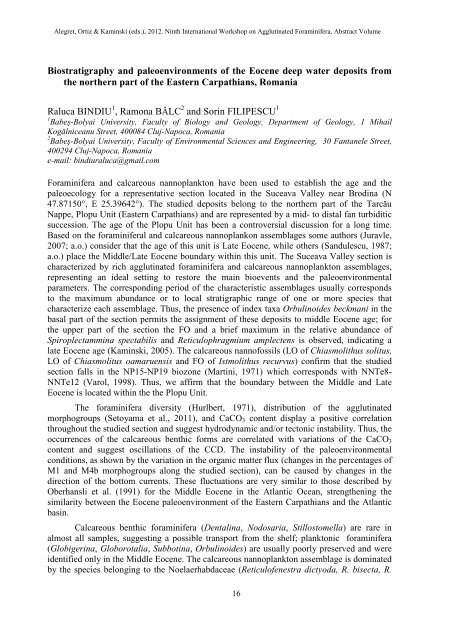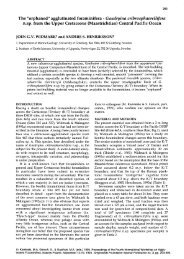Full Text | Download - Grzybowski Foundation - The ...
Full Text | Download - Grzybowski Foundation - The ...
Full Text | Download - Grzybowski Foundation - The ...
You also want an ePaper? Increase the reach of your titles
YUMPU automatically turns print PDFs into web optimized ePapers that Google loves.
Alegret, Ortiz & Kaminski (eds.), 2012. Ninth International Workshop on Agglutinated Foraminifera, Abstract Volume<br />
Biostratigraphy and paleoenvironments of the Eocene deep water deposits from<br />
the northern part of the Eastern Carpathians, Romania<br />
Raluca BINDIU 1 , Ramona BĂLC 2 and Sorin FILIPESCU 1<br />
1 Babeş-Bolyai University, Faculty of Biology and Geology, Department of Geology, 1 Mihail<br />
Kogălniceanu Street, 400084 Cluj-Napoca, Romania<br />
2 Babeş-Bolyai University, Faculty of Environmental Sciences and Engineering, 30 Fantanele Street,<br />
400294 Cluj-Napoca, Romania<br />
e-mail: bindiuraluca@gmail.com<br />
Foraminifera and calcareous nannoplankton have been used to establish the age and the<br />
paleoecology for a representative section located in the Suceava Valley near Brodina (N<br />
47.87150°, E 25.39642°). <strong>The</strong> studied deposits belong to the northern part of the Tarcău<br />
Nappe, Plopu Unit (Eastern Carpathians) and are represented by a mid- to distal fan turbiditic<br />
succession. <strong>The</strong> age of the Plopu Unit has been a controversial discussion for a long time.<br />
Based on the foraminiferal and calcareous nannoplankon assemblages some authors (Juravle,<br />
2007; a.o.) consider that the age of this unit is Late Eocene, while others (Sandulescu, 1987;<br />
a.o.) place the Middle/Late Eocene boundary within this unit. <strong>The</strong> Suceava Valley section is<br />
characterized by rich agglutinated foraminifera and calcareous nannoplankton assemblages,<br />
representing an ideal setting to restore the main bioevents and the paleoenvironmental<br />
parameters. <strong>The</strong> corresponding period of the characteristic assemblages usually corresponds<br />
to the maximum abundance or to local stratigraphic range of one or more species that<br />
characterize each assemblage. Thus, the presence of index taxa Orbulinoides beckmani in the<br />
basal part of the section permits the assignment of these deposits to middle Eocene age; for<br />
the upper part of the section the FO and a brief maximum in the relative abundance of<br />
Spiroplectammina spectabilis and Reticulophragmium amplectens is observed, indicating a<br />
late Eocene age (Kaminski, 2005). <strong>The</strong> calcareous nannofossils (LO of Chiasmolithus solitus,<br />
LO of Chiasmolitus oamaruensis and FO of Istmolithus recurvus) confirm that the studied<br />
section falls in the NP15-NP19 biozone (Martini, 1971) which corresponds with NNTe8-<br />
NNTe12 (Varol, 1998). Thus, we affirm that the boundary between the Middle and Late<br />
Eocene is located within the the Plopu Unit.<br />
<strong>The</strong> foraminifera diversity (Hurlbert, 1971), distribution of the agglutinated<br />
morphogroups (Setoyama et al., 2011), and CaCO3 content display a positive correlation<br />
throughout the studied section and suggest hydrodynamic and/or tectonic instability. Thus, the<br />
occurrences of the calcareous benthic forms are correlated with variations of the CaCO3<br />
content and suggest oscillations of the CCD. <strong>The</strong> instability of the paleoenvironmental<br />
conditions, as shown by the variation in the organic matter flux (changes in the percentages of<br />
M1 and M4b morphogroups along the studied section), can be caused by changes in the<br />
direction of the bottom currents. <strong>The</strong>se fluctuations are very similar to those described by<br />
Oberhansli et al. (1991) for the Middle Eocene in the Atlantic Ocean, strengthening the<br />
similarity between the Eocene paleoenvironment of the Eastern Carpathians and the Atlantic<br />
basin.<br />
Calcareous benthic foraminifera (Dentalina, Nodosaria, Stillostomella) are rare in<br />
almost all samples, suggesting a possible transport from the shelf; planktonic foraminifera<br />
(Globigerina, Globorotalia, Subbotina, Orbulinoides) are usually poorly preserved and were<br />
identified only in the Middle Eocene. <strong>The</strong> calcareous nannoplankton assemblage is dominated<br />
by the species belonging to the Noelaerhabdaceae (Reticulofenestra dictyoda, R. bisecta, R.<br />
16



